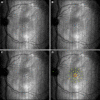The Effect of Perceptual Learning on Face Recognition in Individuals with Central Vision Loss
- PMID: 32609296
- PMCID: PMC7425703
- DOI: 10.1167/iovs.61.8.2
The Effect of Perceptual Learning on Face Recognition in Individuals with Central Vision Loss
Abstract
Purpose: To examine whether perceptual learning can improve face discrimination and recognition in older adults with central vision loss.
Methods: Ten participants with age-related macular degeneration (ARMD) received 5 days of training on a face discrimination task (mean age, 78 ± 10 years). We measured the magnitude of improvements (i.e., a reduction in threshold size at which faces were able to be discriminated) and whether they generalized to an untrained face recognition task. Measurements of visual acuity, fixation stability, and preferred retinal locus were taken before and after training to contextualize learning-related effects. The performance of the ARMD training group was compared to nine untrained age-matched controls (8 = ARMD, 1 = juvenile macular degeneration; mean age, 77 ± 10 years).
Results: Perceptual learning on the face discrimination task reduced the threshold size for face discrimination performance in the trained group, with a mean change (SD) of -32.7% (+15.9%). The threshold for performance on the face recognition task was also reduced, with a mean change (SD) of -22.4% (+2.31%). These changes were independent of changes in visual acuity, fixation stability, or preferred retinal locus. Untrained participants showed no statistically significant reduction in threshold size for face discrimination, with a mean change (SD) of -8.3% (+10.1%), or face recognition, with a mean change (SD) of +2.36% (-5.12%).
Conclusions: This study shows that face discrimination and recognition can be reliably improved in ARMD using perceptual learning. The benefits point to considerable perceptual plasticity in higher-level cortical areas involved in face-processing. This novel finding highlights that a key visual difficulty in those suffering from ARMD is readily amenable to rehabilitation.
Conflict of interest statement
Disclosure:
Figures







Similar articles
-
Combining fixation and lateral masking training enhances perceptual learning effects in patients with macular degeneration.J Vis. 2020 Oct 1;20(10):19. doi: 10.1167/jov.20.10.19. J Vis. 2020. PMID: 33064123 Free PMC article.
-
Visual rehabilitation using microperimetric acoustic biofeedback training in individuals with central scotoma.Clin Exp Optom. 2019 Mar;102(2):172-179. doi: 10.1111/cxo.12834. Epub 2018 Sep 25. Clin Exp Optom. 2019. PMID: 30253443
-
We don't all look the same; detailed examination of peripheral looking strategies after simulated central vision loss.J Vis. 2020 Dec 2;20(13):5. doi: 10.1167/jov.20.13.5. J Vis. 2020. PMID: 33284309 Free PMC article.
-
Vision rehabilitation for age-related macular degeneration.Int Ophthalmol Clin. 1999 Fall;39(4):143-62. doi: 10.1097/00004397-199903940-00010. Int Ophthalmol Clin. 1999. PMID: 10709586 Review.
-
Neural and perceptual adaptations in bilateral macular degeneration: an integrative review.Neuropsychologia. 2025 Aug 13;215:109165. doi: 10.1016/j.neuropsychologia.2025.109165. Epub 2025 May 8. Neuropsychologia. 2025. PMID: 40345486 Review.
Cited by
-
A randomized study of network-based perception learning in the treatment of amblyopia children.Int J Ophthalmol. 2022 May 18;15(5):800-806. doi: 10.18240/ijo.2022.05.17. eCollection 2022. Int J Ophthalmol. 2022. PMID: 35601173 Free PMC article.
References
-
- Legge GE, Grosmann C, Pieper CM. Learning unfamiliar voices. J Exp Psychol Learn Mem Cogn. 1984; 10: 298–303.
-
- Riddoch MJ, Johnston RA, Bracewell RM, Boutsend L, Humphreys GW. Are faces special? A case of pure prosopagnosia. Cogn Neuropsychol. 2008; 25: 3–26. - PubMed
-
- Kleen SR, Levoy RJ. Low vision care: correlation of patient age, visual goals, and aids prescribed. Optom Vis Sci. 1981; 58: 200–205. - PubMed
-
- Bullimore MA, Bailey IL, Wacker RT. Face recognition in age-related maculopathy. Invest Ophthalmol Vis Sci. 1991; 37: 2020–2029. - PubMed

